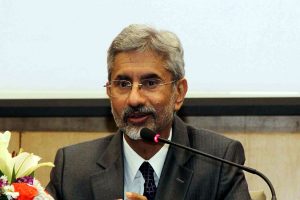Proclaimed as ‘Loknayak’, Jayaprakash Narayan wrote in his prison diary on 22 July 1975, “I had always believed that Mrs Gandhi had no faith in democracy, that she was by inclination and conviction a dictator.” By 25 June 1975, with the Emergency having been declared and most opposition leaders imprisoned, JP’s perceptions were a brooding dark reality. Imprisoned were Rajmata Vijayaraje Scindia, Morarji Desai, Charan Singh, JB Kripalani, George Fernandes, Atal Bihari Vajpayee, LK Advani, Mulayam Singh Yadav, Raj Narain, Arun Jaitley, Jai Kishan Gupta, SN Sinha and Rajmata Gayatri Devi of Jaipur.
Rashtriya Swayamsevak Sangh (RSS) and Jamaat-e-Islami, along with some political parties, were banned. “Please do not destroy the foundations that the Fathers of the Nation, including your noble father, had laid down,” he wrote in a letter to Mrs Gandhi, adding, “There is nothing but strife and suffering along the path that you have taken. You inherited a great tradition, noble values, and a working democracy. Do not leave behind a miserable wreck of all that. It would take a long time to put all that together again. That it would be put together again, I have no doubt.
Advertisement
A people who fought British imperialism and humbled it cannot accept indefinitely the indignity and shame of totalitarianism. The spirit of man can never be vanquished, no matter how deeply suppressed. In establishing your personal dictatorship, you have buried it deep. But it will rise from the grave…” The Loknayak of 1975 had a long personal and political association with the Nehru-Gandhi family. Since the late 1920s, he had worked as a Congress worker in tandem with Pt Jawaharlal Nehru whom he addressed as ‘Bhai’, and his daughter was always ‘Indu’ for him. With the ominous Emergency in force, JP wrote to a Prime Minister gone astray, “You have talked of social democracy.
What a beautiful image those words call to the mind. But you have seen in eastern and central Europe how ugly the reality is. Naked dictatorship and, in the ultimate analysis, Russian overlordship. Please, please do not push India toward that terrible fate.” JP faced opposition from his political friends, allies, socialists, and members of Parliament who felt the anti-Indira agitation had been launched without adequate preparations. Wrote the veteran reporter-editor Kuldip Nayar in ‘The Judgement’, in private some leaders compared his ( JP’s) actions with those of Prime Minister Nehru who, in October 1962, said in public that he had asked the military to throw out the Chinese from Indian soil. “The result in both cases, they argued, had been a disaster.”
Through the 1960s till 1977 when the Janata Party overthrew a discredited Congress regime, Jayaprakash was the leader among conscience-keepers of the nation who could understand political issues with the same insight as economic and social problems plaguing the population. If agriculture was stagnant, with droughts affecting several states, if unemployment was rising, JP could join the dots, highlight the suffering of people due to macro-economic policies and micro-level administrative bungling. The 1967 general elections witnessed the Congress seat tally down to 283; in several state elections the party was ousted from power, including Uttar Pradesh, Bihar, Kerala, Punjab, Orissa, West Bengal, Rajasthan and Tamil Nadu.
The rise of a multi-party Opposition was unnerving and unsettling for Mrs Gandhi; for a public-spirited Gandhian, socialist leader like JP, it threw open platforms for nation-building like never before. The Congress under Indira from 1967 to 1971 undertook “a radical, socialist, left-of-centre programme of reforms that included plans to discontinue princely privileges by abolishing privy purses; guarantee of minimum wages for rural and industrial labour; nationalisation of the insurance sector; social control of banking institutions; state trading in foodgrains and removal of monopolies.
These plans found ideological resonance with the socialist group with the party led by Young Turks like Mohan Dharia and Chandra Shekhar,” wrote Sujata Prasad in ‘The Dream of Revolution’, the biography of JP she co-authored with her illustrious father Dr Bimal Prasad. In a scathing attack on the Congress, and on Indira’s style of leadership, JP said, “Paradoxical though it may sound, the Congress despite its massive electoral victories of 1971 and 1972, is today a little more than a hollow shell.
It has no inner strength and substance, and is presently going on huge doses of funds and the charisma of its leader. There is little or no internal democracy left in it and its state leaders and chief ministers are mostly handpicked men…the present state of affairs might suit Indira Gandhi’s style of leadership but spells ruin for the Congress as a democratic organization, and ipso facto for Indian democracy itself.” The JP papers titled ‘Prospects of Democracy in India:
A Hopeless Situation’ (August 1972) are quoted in Sujata Prasad’s biography, revealing the leader’s anguish, anger and angst on the state of national affairs. While JP’s world lay in a shambles, Mrs Gandhi announced on 1 July the contours of her make-believe world. She had selected 20 points (originally 21) out of the 150 suggestions she had received from her ministries. There was no deep thinking behind the choice of the “points” ~ she picked up what she thought would be easy for people to understand, good conversation pieces at best. But many points were indeed laudable and nobody could take exception to them even in today’s time and age when political manifestos are echoing similar programmes. The twenty points were:
1) Scaling down prices of essential commodities and streamlining their production and distribution.
2) Economizing government expenditure.
3) Implementing agricultural land ceilings and speeding up distribution of surplus land and compilation of land records.
4) Stepping up house-site availability to the landless and weaker sections.
5) Declaring bonded labour illegal.
6) Planning for liquidation of rural indebtedness and a moratorium on recovery of debts from the landless, labourers, small farmers and artisans.
7) Reviewing laws on minimum agricultural wages.
8) Bringing five million more hectares under irrigation and preparing a national programme for use of underground water.
9) Increasing power production.
10) Developing the handloom sector and improving the quality and supply of people’s cloth.
11) Effecting ‘‘socialization” of urban and urbanizable land and having a ceiling on ownership and possession of vacant land.
12) Having special squads for valuation of conspicuous consumption and prevention of tax evasion and summary trials and deterrent punishment of economic offenders.
13) Special legislation for confiscation of smugglers’ properties.
14) Liberalizing investment procedures and taking action against misuse of import licences.
15) New schemes for workers’ associations in industry.
16) National permit schemes for road transport.
17) Income tax relief io middle class ~ exceptional limit placed at Rs 8,000.
18) Essential commodities at controlled prices to students in hostels.
19) Books and stationery at controlled prices.
20) New apprenticeship scheme to enlarge employment and training, especially of the weaker sections.
Mrs Gandhi had always given an economic cover to her political manoeuvres, explained Kuldip Nayar in ‘The Judgement’, adding, she had done it in 1969 at the time of the Congress split and in 1971 at the time of the midterm poll, and she had got away with it. The people had always thought that her fight was for the country’s economic good and not for her own survival. This time also she believed that the twenty-point programme would hide the move to sustain herself in power.
And she looked like succeeding for the time being. The twenty-point programme came to dominate the media and every official and non-official discussion. Hoardings and posters came up everywhere, listing the points and carrying large portraits of her. There was nothing new in the “new” programme. One state said, “Give us the money and everything will be done; what is the use of mere talking.” Tamil Nadu’s comment was typical: the state had already implemented nineteen out of the twenty points. The underground movement took time to get organized, with two groups, one led by George Fernandes, and the other by Nanaji Deshmukh of Jana Sangh. Each issued instructions for a civil disobedience campaign against the ‘Indian Fascist-Russian Axis’.
An eight-page cyclostyled paper was circulated, “Read and let others read”; it called on leaders of all political persuasions to bury differences and unite in a struggle to “restore democracy to India.” It went on to warn the opposition, “There is no time for ideological quibbling or personality clashes. We have only one aim and that is to defeat fascism and to restore democracy with its fundamental freedoms and pluralist political institutions.” The call for unity resonates till date
(The writer is an authorresearcher on history and heritage issues and a former Deputy Curator of Pradhanmantri Sangrahalaya)











